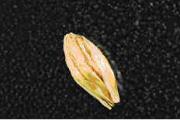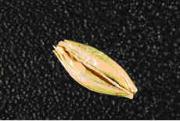Weather damage of barley
Weather damage of barley can take different forms including:
- kernel discolouration
- germ-end staining
- fungal staining or mould
- pre-harvest sprouting
- cleaved barley
- varietal purity
- grain quality.
Kernel discolouration
Kernel discolouration involves the colour change from the light straw colour of bright grain to a deep yellow/tan coloured grain (or caramel colour when extreme). It involves the discolouration of the grain without, it seems, the involvement of fungi and is caused by light showers of rain, high humidity or even heavy morning dew.
Germ-end staining
The dark brown or black staining of the germ-end of the grain is referred to as germ-end staining or black point. Preliminary studies indicate that this staining may involve peroxidase enzymes rather than fungal activity.
Fungal staining or mould
The darker grey staining or appearance of distinctive spots of visible mould on the grain that appears after heavier rain, is associated with a number of fungi and is the more severe form of weather damage. Alternaria alternata is the fingi most frequently isolated on barley subjected to weather damage in WA.
Pink stained barley
Traces of pink stained barley grains were identified in grain samples from 2003 and 2004 harvests. Pink staining of barley can have a number of causes. The most obvious is the use of chemical applied as a seed treatment (ie. 'pickling'). However, pink and blue staining can be caused by coloured foam marker used as a spray guide when crop-topping (see photograph, Figure 1). Foam markers are considered to be weather fast and readily attach to organic matter including plant material. Pink staining can also occur as a form of germ end staining.
Grain with pink staining has a poor visual appearance which may be confused with grain that has been pickled, even if this was not the original cause of staining. It does not conform to grain hygiene standards required by regulatory authorities within Australia or importing countries. If stained grain is found on an export shipment, it can potentially lead to the entire cargo being rejected and jeopardise our valuable international markets.
To avoid affecting a stack and jeopardising our international markets, stained grain must not enter storage that contains barley that is destined for international markets. Growers should maintain good hygiene practises during harvest to prevent 'pickled' grain from contaminating grain deliveries. If growers use a ground spray rig to make a late application of either a herbicide or an insecticide, they should use white foam marker, rather than pink or blue foam markers, to avoid grain becoming stained.
Pre-harvest sprouting
The sprouting of grain while still in the head is caused by rain or damp conditions during the ripening stage of the crop. The most severe damage results from rainfall when the grain is mature. WA conditions are generally unsuitable for the pre-harvest sprouting of barley, however, this process has been experienced during very wet harvests.
Grain that has sprouted or shot prior to harvest is unsuitable for malting or sowing as there is a loss of seed viability and reduced storage time. In addition, processes associated with sprouting may lead to a reduction in grain yield and increase in fungal activity. Sprouted barley also has a lower value as animal feed.
Barley used for the production of malt must germinate rapidly in the malthouse. For this reason barley breeders, when breeding for the malting industry, have actively selected for varieties that have a lower seed dormancy. As a consequence, malting varieties are often more susceptible to pre-harvest sprouting.
Conditions experienced during the grain filling stage may also affect the susceptibility to pre-harvest sprouting of each variety.
To minimise the risk of pre-harvest sprouting, avoid as much damaging rain as possible through timely harvest of the crop.
Cleaved barley
The cleaving of barley is the splitting of the grain or husk, which is caused by a sudden drop in temperature followed by a rain event during the grain filling period when the grain is at the dough stage. When barley begins to 'turn' in hot drying conditions, waxes form on the outside of the grain and the husk begins to harden. The starchy endosperm inside the grain changes from a milky to a doughy texture. A sudden drop in temperatures of around 10oC, as can occur with an approaching rain front, causes the husk to rapidly harden. The proceeding rain is absorbed by the plant roots and moved to the filling grain. The grain becomes swollen and the dry, non-expanding husk can split at the crease, back or the side of the grain. Once split, the starchy endosperm is exposed to the elements.
Maltsters prefer to buy barley grain that is intact with no damage to the husk, embryo and starchy endosperm. Grain that is split or cleaved allows the water to quickly enter and saturate the inside of the grain during the malting process. This results in an uneven germination and the production of non-uniform malt or the leakage of grain contents out through the split making them unavailable for the brewing process.
There are two types of cleaving in barley:
- the peeling of the husk from the awn end of the grain along its side where the lemma overlaps the palea giving the appearance that the husk is too small to cover the entire grain.
- the grain splits along the crease, side or back of the grain. The split grain can be broken with a thumbnail pressed into the crease, whereas healthy barley grains can not be broken easily.

Figure 2a Split along side of grain

Figure 2b Split along crease of grain
Varietal purity of malting barley
Malting barley must be grown, stored and shipped in pure single-variety lots if top quality malt and beer is to be produced.
Barley varieties differ in their chemical characteristics during the malting process. They contain different levels of important enzymes and other characteristics that are critical for the maltster to produce high quality malt. When malting a particular variety, the maltster will adjust the processing schedule to suit each variety. When a lot contains either a wrongly declared variety or a mixed batch, the malting process is poorly regulated, over modification of the malt can occur and beer processing is affected.
Feed barley varieties are so declared because they are unsuitable for malting. They lack some of the critical enzymes that are required or have characteristics that make them unsuitable, such as high levels of beta-glucans that clog up the filters in the brewery.
Before sowing, ensure you know that your barley is pure and of the correct variety.
If visual cues are not enough then the grain will need to be tested at an accredited laboratory for varietal purity. The most common method used to determine varietal purity is based on mass spectrometry analysis of protein profiles in grains, but newer methods such as DNA microsatellites and DArT technology are also available and being used.
Testing
- AGWEST Plant Laboratories offer a mass spectrometry test that compares the protein profile of a combined sample or of 30 individual seeds or of 150 individual seeds. Those tests range from $135 to $694 to conduct. Higher levels of accuracy can be obtained by analysing more seeds, but the price also increases as more seeds are done. They also offer a DNA microsatellite test for $298.
Grain quality
Buyers of malting barley prefer grain that has a high germination rate, large kernel size, good hectolitre weight, correct protein level and bright grain with intact husk that is free of mould or weather staining. Feed barley buyers prefer grain that is clean, bright, plump with good hectolitre weight and low in moisture. Grain growers must produce barley with a high grain quality to receive the maximum price per tonne for their grain.
When producing malting barley there are some factors, such as seasonal conditions, that influence quality but cannot be controlled by growers. However, there are factors that growers can manage that will increase their chance of producing viable grain with the optimum grain size, protein and brightness that achieves the premium malting grade
Germination
Germination is the most important quality characteristic of malting barley. In order to be made into malt the barley grain must germinate. Grain with less than 98% germination is unsuitable for malting. During the malting process, maltsters germinate the grain under controlled conditions. The germination process is required to prepare the grain for brewing. Varieties of barley that cannot germinate are classified as feed. The germination of grain is not critical for feed barley.
Factors affecting germination
The factors that influence germination percentage are:
- Weather conditions at harvest - Wet conditions at harvest may initiate germination (pre-harvest sprouting). They may also induce secondary dormancy though the growth of mould and fungi and therefore delay the earliest time at which a variety is suitable for malting.
- Crop growth stage when harvested - If the crop is harvested before physiological maturity (before flag leaf and peduncle have turned from green to yellow), then the sample will have a large proportion of immature grains. These immature grains will have a much lower germination percentage than mature grains.
- Grain drying conditions - If the grain is dried to temperatures above 43C then the germination percentage will decrease.
- Grain storage conditions - Poorly stored grain can be subject to large temperature and moisture gradients which may affect the viability of the embryo and hence the germinative ability of the grain. In addition poorly stored grain is at greater risk of insect infestation.
Variety
Some varieties are more susceptible to weather damage at harvest than others due to their inherent dormancy and sensitivity to pre-harvest sprouting and should not be left standing in the paddock for too long after maturity.
Acknowledgements: This information comes from the 'Barley production in Western Australia' site, first compiled by Roslyn Jettner and Pam Burgess from contributions by officers of the Department of Agriculture and Food, Western Australia then updated in 2006 by Richard O'Donnell, Alaina Smith and in 2013 by Blakely Paynter.
